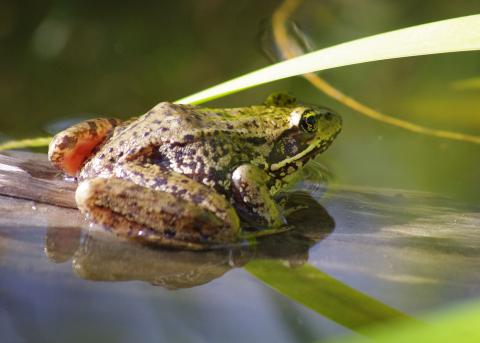You never forget your first amphibian egg mass
April 22, 2022
It’s a beautiful sunny February day that’s cold but clear, and I’m at a wetland in Washington County. No big deal, right? The only difference today: I’m not on land looking at the water…I’m in the water. Nearly neck-deep water! I’m wearing chest waders, so I stay dry, but the cold still takes my breath away.
I’m distracted by the feeling of being deep in water and yet not wet, but I’m trying hard to concentrate on scanning the area near the reeds and branches ahead of me, to look for amphibian egg masses.
Why am I doing this? I’m participating in Metro’s amphibian egg mass survey training. Their amphibian egg mass monitoring program uses volunteers to track four native pond-breeding amphibians: the Pacific chorus frog, Northwestern salamander, long-toed salamander and Northern red-legged frog.
These four amphibians can all be found in Oregon’s forests, and you can learn more about them and their habitat needs in the Oregon Forest Resources Institute’s new Forest Amphibians publication. They also serve as indicator species, which can be used to help gauge whether regional restoration efforts are helping more native amphibians thrive. Surveying for the egg masses each winter helps scientists track their numbers, as well as the overall health of wetlands in the region.
The masses come in a variety of sizes depending on the species and the stage of development, but all are clear gelatinous globs with dots, hooked to aquatic vegetation and camouflaged to fit into their environment. This makes them very difficult to spot. Think of it like an Easter egg hunt in the water, but without the pastel-colored eggshells.
It’s my first time out, and I don’t have a clue what I’m looking for; I’m mainly trying not to fall into a hole made by a beaver.
Conventional wisdom for this group says that the first time out you’re overwhelmed. The second time out, you’re simply confused. By your third trip to monitor, you have a sense of what you’re looking for and where to find it. In addition to identifying the egg masses, there are research protocols that must be followed to standardize the data collected. For example, we used a stopwatch to determine the number of egg masses found in a running time period. During my training, I found chorus frog and long-toed salamander eggs. My most unforgettable find was a Northwestern salamander egg mass, which is about the size of a tennis ball.
The survey season is over for this year. But I’ll be back next January, wading through some of the region’s most beautiful aquatic areas, searching for and compiling data on amphibians. I’m having fun, and it’s nice to know the information I contribute helps guide restoration programs aimed to aid native amphibians that call Metro’s parks and natural areas home.
Norie Dimeo-Ediger
Director of K-12 Education Programs
Image credit: Martyne Reesman, Oregon Department of Fish and Wildlife
